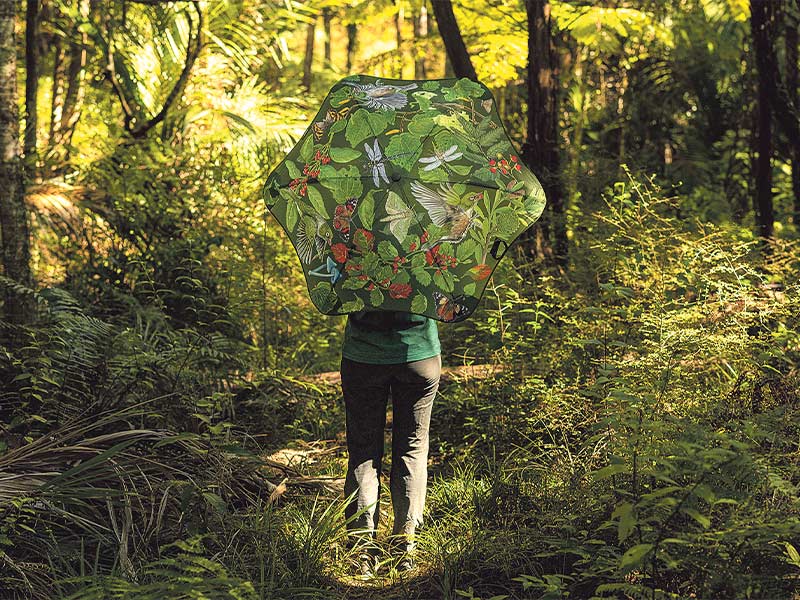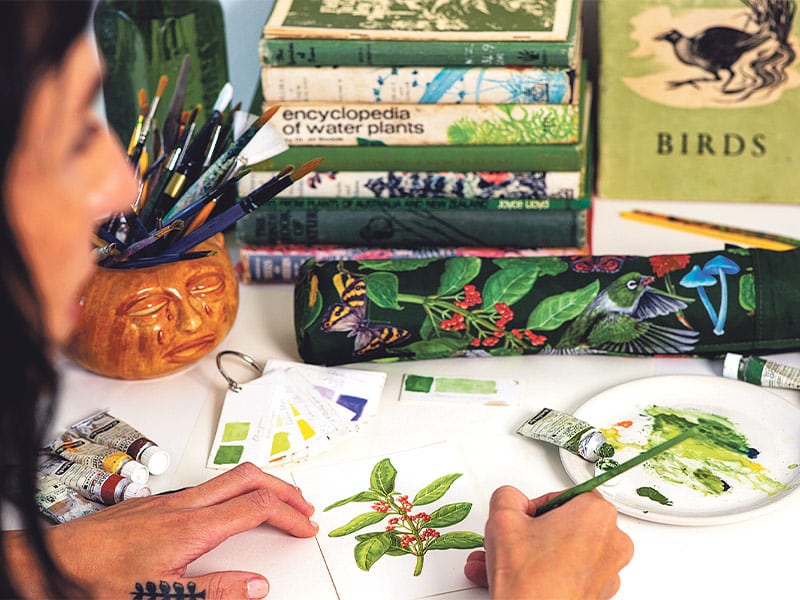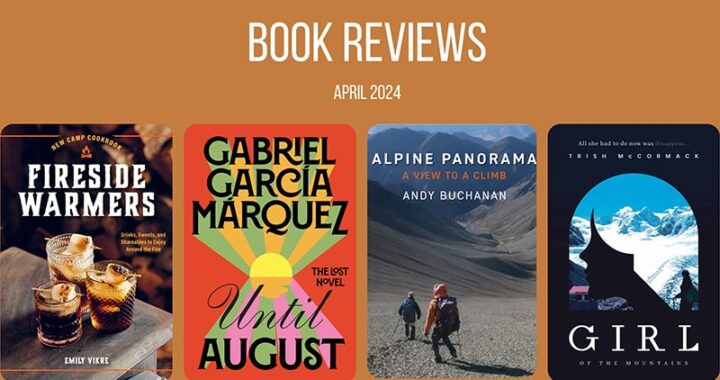Canopy creations: celebrating NZ’s biodiversity
6 min read
The visually stunning umbrellas celebrates 100 years of Forest & Bird. Photo: Supplied
Commemorating a century-long commitment to conservation, Forest & Bird and BLUNT have collaborated to unveil two new limited-edition umbrella designs that capture the essence of Aotearoa New Zealand. Rachel Walker and Erin Forsyth are the two Kiwi artists behind the designs. We delve into their work and explore the inspiration behind their beautiful artworks.
In conversation with Rachel Walker

The first of the two designs, a bird-inspired watercolour masterpiece by Rachel Walker, captures the vibrant essence of native parrots – the kea and kākā – in flight. This showcase image embodies the colour, texture, and movement of these charismatic cousins, serving as a visual ode to New Zealand’s unique avian treasures.
Known for her watercolour, spray paint, pen, and ink artworks, Rachel is inspired by the natural world. Her distinctive, drippy, and energetic style masterfully blends loose forms with precise details, capturing the essence and beauty of birds, sea creatures, reptiles, and wild animals.
Where do you draw inspiration from?
Currently, the natural world. Mother Nature knows all the best colour combos. And there are so many incredible creatures out there.

Tell us about your relationship with Forest & Bird
I’ve had the pleasure of collaborating on some exciting projects with Forest and Bird, including a couple of fundraising group exhibitions and multiple features of my artwork in their magazine. Prior to this collaboration, I designed a set of stamps for NZ Post commemorating the 100th anniversary of Forest and Bird.
Knowing that there’s a dedicated community of passionate and organised individuals working to protect our natural ecosystems is truly gratifying. In today’s increasingly precarious environment for both creatures and forests, their efforts are crucial, and it’s important for us to lend our support.
Can you tell us the design process behind this beautiful canopy?
I kicked off the design process with pencil sketches of the individual kea and kākā. Using Photoshop, I manipulated their positions in the umbrella template until they appeared natural, making necessary adjustments to wings and other details.
The next step involved brainstorming the colour palette, aiming for a stormy sky ambience with various bluey greys to accentuate the stunning scarlet feathers. These feathers, along with the inky splashy bits, are my favourite elements in the design. To bring the vision to life, I painted each bird separately on white watercolour paper, had them professionally scanned, and utilised the digital versions to layer them in the umbrella template. Finally, I added the background colour, completing the intricate process.
In conversation with artist Erin Forsyth

The second design, a forest-inspired canopy, pays homage to the rich biodiversity found in Aotearoa’s ngahere (forest), featuring winged species such as tauhou silvereye, kahukura red admiral butterfly, and puriri moth in a stunning creation by artist and illustrator Erin Forsyth.
Where do you draw inspiration from?
I like the Waikowhai walkways near my old place. This is an old-growth forest remnant, and my favourite part is dominated by kohekohe (Dysoxylum Spectabile) but there’s also kahikatea (Dacrycarpus dacrydioides) and rewarewa (Knightis excelsa). I think it’s classified as a ‘tawa, koekohe, rewarewa,hīnau, podocarp forest’ (kahikatea being the podocarp) – a vulnerable forest type under the IUCN threatened species classification. The way light falls through the ancient canopy of kohekohe leaves is beautiful and the understory is quite different to many forests in the region.
When I first visited this forest, I was surprised to see what I thought was taurepo growing there. I’d seen it only once before at Ōtari-Wilton’s bush in Wellington and then painted it a number of times.
It’s an unusual flowering shrub among the endemics, as the flowers are large, orange, and tubular. On a later visit, it was in flower, which was the best confirmation. This plant trails along a rough bank edge right by the track. Recently it occurred to me that it makes sense for kohekohe and taurepo to be growing together, as they both exhibit characteristics of tropical plants not present in any other native species. I’m so glad they survived the slips.
I like to visit the same places in my neighbourhood wherever I am living to see what the plants are doing. Sometimes these might be suburban plantings and sometimes old-growth forests. I’m so lucky to have both within walking distance.
Before I really got into all of this, the potter Barry Brickell recommended the book Plants and Shrubs of New Zealand by A. H. Poole illustrated by Nancy Adams and told me how he would walk around the North Shore (Auckland) trying to find as many of the plants as he could.
Later, the botanist Pieter B. Pelser, lecturer in Plant Systematics and curator of the herbarium University of Canterbury, recommended we repeat a plant’s name out loud or in our heads whenever we see it. I have difficulty absorbing this type of information, but I stay in the practice of noticing.

Tell us about your relationship with Forest & Bird
The work of Forest and Bird is remarkable. It represents the best of humanity’s intent to continue to relate to the natural world and to remain a contributing part of it. That it exists outside of political jurisdiction is incredibly powerful, as it roots with integrity to the wellbeing of the natural world at its core, as opposed to forming environmental policy making around party agenda.
I have deep appreciation for the work of this organisation and to get to collaborate with them has been a dream come true.
Can you tell us the design process behind this beautiful canopy?
Creating the design for this collaboration was such a pleasure. In terms of the overall practical design, I knew I wanted it to be really playful. To me, an umbrella needs to be twirled so I wanted a design that would look cool when you spin it. Makes rainy days better.
I wanted the design to look like a little eddy had gently lifted these plants and animals up for you to observe. It’s important to me to celebrate and draw attention to biodiversity. I also wanted to have species people might recognise like the blue mushroom werewere-kokako (Entoloma hochstetteri) so they feel connected.
I wanted to illustrate charismatic native plants from both of the main islands and take smaller members of the animal kingdom, such as dragonflies, butterflies, and moths and make them the heroes of the design.
The tauhou or silvereye plays on my animation background and is represented in different sequences of motion. For several years, I nursed one of these birds and it would sit on my shoulder, on top of my head, or on my paintbrush while I worked. This was when I was preparing my first natural history works for exhibition. The history of these birds being self-introduced on a gust of wind is relative and from this experience, they have become meaningful to me. That such a small being had such a big personality and was one life of billions on the planet still just blows my mind.
In the way the canopy is laid out, overall species are not competing but harmonious even though they’d never be found together like this in nature. The dark green background was a must-have for Forest and Bird.
The limited-edition umbrellas are available (until sold out) for $149 on bluntumbrellas.co.nz or at selected participating retailers.



